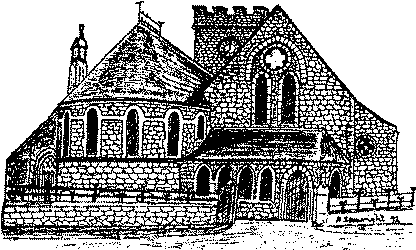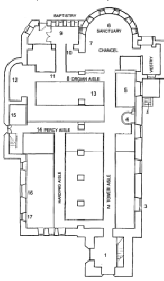|

Welcome to Dromore Cathedral, a 17th Century Church, built on a site
used for Christian worship for 1500 years.
St. Colman of Dromore set up a small 'daub and wattle'
church on this site in 510 AD. Probably thatched with reeds from the
River Lagan which flows beside it, this church site has been, for the 15
centuries since, a location for the worship of Jesus Christ, the
Redeemer of all humanity. You can share the privilege of many people
before you by entering this place of worship to learn how God's people
have created and used this place as a centre for holiness.
Little evidence is available for the first 700 years of St. Colman's
Church. We have no indication of either its style or size.
In the twelfth century the English King Henry Il revised a system of
dioceses and bishops which covered the whole of Ireland. One of those
dioceses, named DROMORE, took as its base this Cathedral Church. There
had been bishops and abbots of Dromore before then, but from this time
the history becomes more complete.
A medieval church, about which no record exists, was
destroyed in the late 1500's. It was James I who, in 1609, issued
Letters Patent giving the Church of St. Colman a new title and a new
status: the Cathedral Church of Christ the Redeemer, Dromore. That
building was destroyed in 1641 and a new structure, of which small
portions are still visible was built by Bishop Jeremy Taylor in 1661.
A narrow structure, about 20 feet wide, 100 feet long
was first built. It forms the base of the current Tower Aisle. A Tower
was built and soon dismantled. The Percy Aisle was added by Bishop
Thomas Percy in 1811. It sits at right angles to the Tower Aisle,
opposite the pulpits. A Semicircular Sanctuary in memory of Jeremy
Taylor was designed by Thomas Drew F.R.S.A. during the ministry of Canon
Beresford Knox in 1870. The Organ Aisle and baptistry were added at this
time, and the Church was made rectangular with the addition of the
Harding Aisle in 1899.
A careful inspection of the exterior stonework shows the
extent of these additions quite clearly.
Please walk around, taking time to reflect on the
motives which have driven our ancestors to honour God with this
wonderful place of Worship.
Take a walk
 1.
The Tower Porch 1.
The Tower Porch
As you look around the tower porch, see the curious oak POOR MAN'S BOX,
and the disused FONT dating from the 1660's. The current tower was built
in 1808. It was refurbished in 1989 in memory of Canon R. W. Kilpatrick,
rector from 1948-1958. The West Door is traditionally used only for
funerals. There are two Bells in the Tower.
2. The Tower Aisle
Until 1899 the first few yards of this Aisle was covered with a Gallery.
The entrance was through a door from the Tower. With the addition of the
Harding Aisle in 1899 it was no longer needed and so Canon Harding
removed it that year.
3. War Memorial Window
The first window on the Tower Aisle wall and its inscribed marble tablet
recall with great respect the parishioners who served and died in time
of war. These are placed as a tribute to those who served
in the First World War (1914-1918). A fuller list of those who served is
on an illustrated inscribed parchment beside the tower door.
4. The Saurin Pulpit
Bishop Saurin (1760-1842) was clearly highly thought of by those who
remembered him by presenting the pulpit of Caen Stone and the plaque to
its right. Its unusual location, being much further down the church than
is normal and facing at right angles to the main aisle, indicates the
centre of the Cathedral in that era.
5. The Choir Stalls (1969)
The three oak Choir Stalls are the newest items of furniture in the
Cathedral, being added as a memorial to William Dickson in 1962.
6. The Reredos and Communion Table
The oak Communion Table with the Reredos immediately behind it were
presented in 1951 as a memorial to those who died in the Second World
War. The panelling to either side was completed in 1952.
Before the days of Archbishop Laud in 1600's, Communion Tables were
located in the centre of churches. Recently this tradition has been
renewed in contemporary places of worship. The Table here was placed in
the centre of the Sanctuary in 1999.
7. The Chancel, with Bishop's Throne and Chapter
Stalls
Each Cathedral has a 'chapter'. Dromore Cathedral Chapter consists of
local clergy who are variously appointed by the Bishop as Dean,
Archdeacon, Chancellor, Precentor, Treasurer and Prebendary. Their
stalls are marked with their titles in Latin. Careful examination of the
misericords reveals wooden reliefs with scenes from the lives of those
they commemorate. Photographs and inscriptions on the Vestry Wall show
the detail. These and the Bishop's oak stall were added in 1894. The
Chancel was built in 1870 as noted above, in memory of Bishop Jeremy
Taylor, whose bones are buried along with three other bishops below the
sanctuary.
8. The Organ Aisle
Added at the same time as the Sanctuary, the Organ Aisle enabled a
larger number of people to worship here. The seats here are very popular
with the regular congregation.
9. The Baptistry and Windows
The Baptistry was relocated here from its original position at the back
of the Tower Aisle in 1870. The windows behind it depict four Christian
virtues, faith, hope, charity, and justice. In baptism people, usually
infants of Christian families, are marked out as Christ's. The prayer of
the church is that they will grow in grace, becoming more like Jesus as
they grow to trust in him themselves.
10. The Old Bible Display Case
Inside the Display Case are three objects of historic interest. The
Bible was given to the Cathedral in 1613! It disappeared during the
troubles of 1641 and reappeared in a shop in Co. Durham in the 19th
century. In 1916 it was transported back to the Cathedral. It is bound
in oak and leather. Also included are a letter and course of sermons by
Bishop Jeremy Taylor and a Prayer book presented by Bishop Thomas Percy.
11. The Window above the Organ Aisle
Above our heads at this point we see a detail of the old interior wall
surrounding two windows of Gresaille Work which date from 1870.
12. The Organ
The Organ dates from 1871 when Conacher of Huddersfield first installed
it. It remains in use tc this day. For many years early in the twentieth
century a fee of a few shillings was paid per annum to the man who
operated the hand operated organ blower through the narrow door to the
left.
13. The Lectern
The Lectern was moved to here in February 1989 to give more room at the
Chancel Steps where it had stood from 1899. The Brass Eagle is often
used to symbolise the Word of God.
14. The Percy Aisle
Bishop Thomas Percy is buried near the Aisle which now bears his name.
He was a much valued 18th Century Cleric and is revered in the town of
Dromore with several other memorials, including an inscription on the
Regent Bridge nearby, and a Pillar in Pinnacle Meadow at the Town Park.
Read the tribute on the Plaque on the Harding Aisle Wall.
15. The Balcony, Windows and Tapestry
There were two balconies stretching out from the rear of the Tower
Aisle. These were removed in 1899 to give the church a better light and
appearance. We have no record of their actual dimensions. The current
balcony was used by the Choir until the 1960s when a robed Choir was
placed in the new Choir Stalls.
The Tapestry on the Balcony can be reached using the
stairs in the porch. This tapestry and one which complements it in Down
Cathedral depict the parishes of the United Diocese of Down and Dromore.
It was made by members of the Mothers' Union Branches of each parish in
the Diocese.
The window in the balcony depicts the arms of John
Meade, 1st Earl of Clanwillian, born 1744.
16. The Double Windows of 1869
The central windows of four in the Harding Aisle are strangely older
than the Aisle itself! These windows, given by the Stott family, and
dated 1869, were part of the Cathedral before the Aisle was added. They
were removed and placed here by kind permission of their donors.
17. The Lazarus Window
Pause awhile here at the last Window before you depart. How fitting that
it should portray the story of Lazarus whose last journey to heaven was
interrupted by Jesus calling him from the tomb. The dead man heard
Jesus' voice and walked back into the light of life. The same event
occurs spiritually when we respond to the call of Jesus Christ to leave
a life of sin and follow him. For Lazarus it meant escape from physical
death for a time. For us it means a guarantee of eternal life and the
assurance of peace with God. Why not take a step today?
Underlying this great edifice is the belief that there is a God who has
made himself known to people through Jesus Christ. This Jesus said to
the people of his day 'Follow Me'. He issues the same invitation today.
May each visitor to our Cathedral know that God is real, that He is
worth the best that this generation has to offer, and that He wants men
and women to follow him today.
Top |